This article explains the rules for executing defer and introduces the defer type. It explains how defer function calls are done, mainly through heap allocation.
Introduction
defer execution rules
The order of execution of multiple defers is “Last In First Out LIFO "
In the above example, the string Naveen is traversed using a for loop and then defer is called. These defer calls act as if they were stacked, and the last defer call pushed onto the stack is pulled out and executed first.
The output is as follows.
The defer declaration will first calculate the value of the parameter
In this example, the variable i is determined when defer is called, not when defer is executed, so the output of the above statement is 0.
defer can modify the return value of a named return value function
As officially stated.
For instance, if the deferred function is a function literal and the surrounding function has named result parameters that are in scope within the literal, the deferred function may access and modify the result parameters before they are returned.
An example is as follows.
However, it should be noted that only the named return value (named result parameters) function can be modified, and the anonymous return value function cannot be modified, as follows.
Because anonymous return-valued functions are declared when return is executed, only named return-valued functions can be accessed in the defer statement, not anonymous return-valued functions directly.
Types of defer
Go made two optimizations to defer in versions 1.13 and 1.14, which significantly reduced the performance overhead of defer in most scenarios.
Allocation on the heap
Prior to Go 1.13 all defers were allocated on the heap, a mechanism that at compile time.
- inserting
runtime.deferprocat the location of thedeferstatement, which, when executed, saves thedefercall as aruntime._deferstructure to the top of the_deferchain of Goroutine. runtime.deferreturnis inserted at the position before the function returns, and when executed, the topruntime._deferis retrieved from Goroutine’s_deferchain and executed sequentially.
Allocation on the stack
New in Go 1.13, deferprocStack implements on-stack allocation of defer. Compared to heap allocation, on-stack allocation frees _defer after the function returns, eliminating the performance overhead of memory allocation and requiring only proper maintenance of the chain of _defer. According to the official documentation, this improves performance by about 30%.
Except for the difference in allocation location, there is no fundamental difference between allocating on the stack and allocating on the heap.
It is worth noting that not all defers can be allocated on the stack in version 1.13. A defer in a loop, whether it is a display for loop or an implicit loop formed by goto, can only use heap allocation, even if it loops once.
|
|
Open coding
Go 1.14 added open coding, a mechanism that inserts defer calls directly into functions before they return, eliminating the need for deferproc or deferprocStack operations at runtime. This optimization reduces the overhead of defer calls from ~35ns in version 1.13 to ~6ns or so.
However, certain conditions need to be met in order to trigger.
- the compiler optimization is not disabled, i.e.
-gcflags "-N"is not set. - the number of
defers in the function does not exceed 8 and the product of thereturnstatements and the number ofdeferstatements does not exceed 15. - the
deferkeyword of the function cannot be executed in a loop.
defer structure
The parameters to note above are siz, heap, fn, link, openDefer which will be covered in the following analysis.
Analysis
In this article, we will start with the heap allocation, we will talk about why the execution rules of defer are as described at the beginning, and then we will talk about the stack allocation of defer and the development coding related content.
The analysis starts with a function call as the entry point.
Allocation on the heap
Named function return value calls
Let’s start with the example mentioned above and look at heap allocation from function calls. Note that running the following example on 1.15 does not allocate directly to the heap, but requires you to recompile the Go source code to force the defer to allocate to the heap.
File location: src/cmd/compile/internal/gc/ssa.go
Print the assembly using the command.
|
|
First of all, let’s look at the main function, there is nothing to say, it is a very simple call to the f function.
The following subparagraph looks at the calls to the f function.
|
|
Since allocation on the defer heap calls the runtime.deferproc function, what is shown in this assembly is an assembly before the runtime.deferproc function is called, which is still very simple to understand.
Because the argument to the runtime.deferproc function is two arguments, as follows.
|
|
In the function call process, the parameters are passed from the right to the left of the parameter list stack, so the top of the stack is pressed into the constant 8, in the 8(SP) position is pressed into the second parameter f.func1-f function address.
See here may have a question, in the pressure into the constant 8 when the size is int32 occupies 4 bytes size, why the second parameter does not start from 4 (SP), but to start from 8 (SP), this is because the need to do memory alignment caused.
In addition to the parameters, it should also be noted that the 16(SP) position is pressed into the 40(SP) address value. So the entire pre-call stack structure should look like the following.
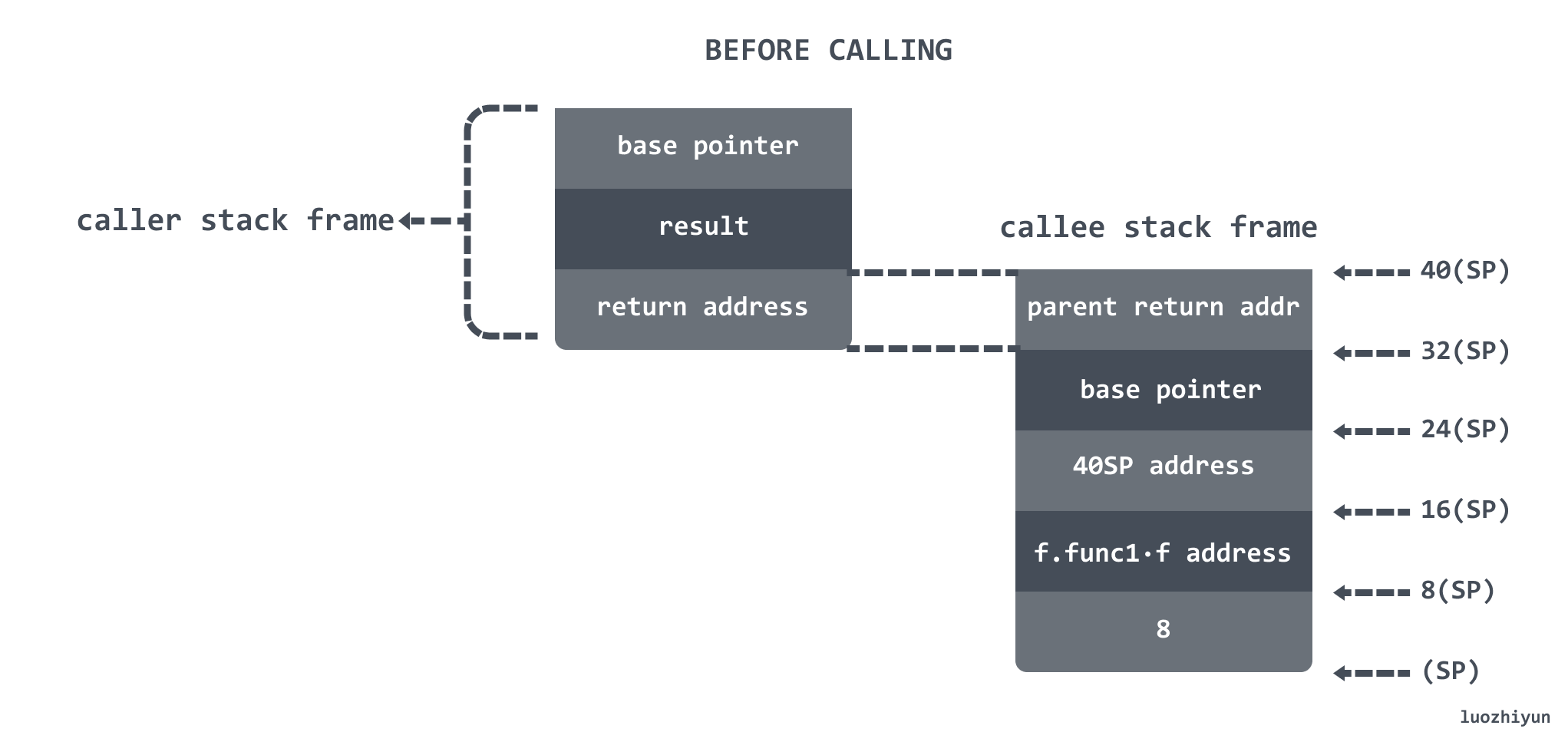
Let’s look at runtime.deferproc :
File location: src/runtime/panic.go
|
|
When calling the deferproc function, we know that the argument siz is passed in as the value at the top of the stack representing the argument size of 8 and the address corresponding to the 8(SP) passed in as the argument fn.
So the two sentences above are actually a combination of the address value we saved in 16(SP) above into the next 8bytes block of memory immediately below defer as the argument to defer. A simple diagram would look like the following, where the argp immediately below defer actually stores the address value saved in 16(SP).
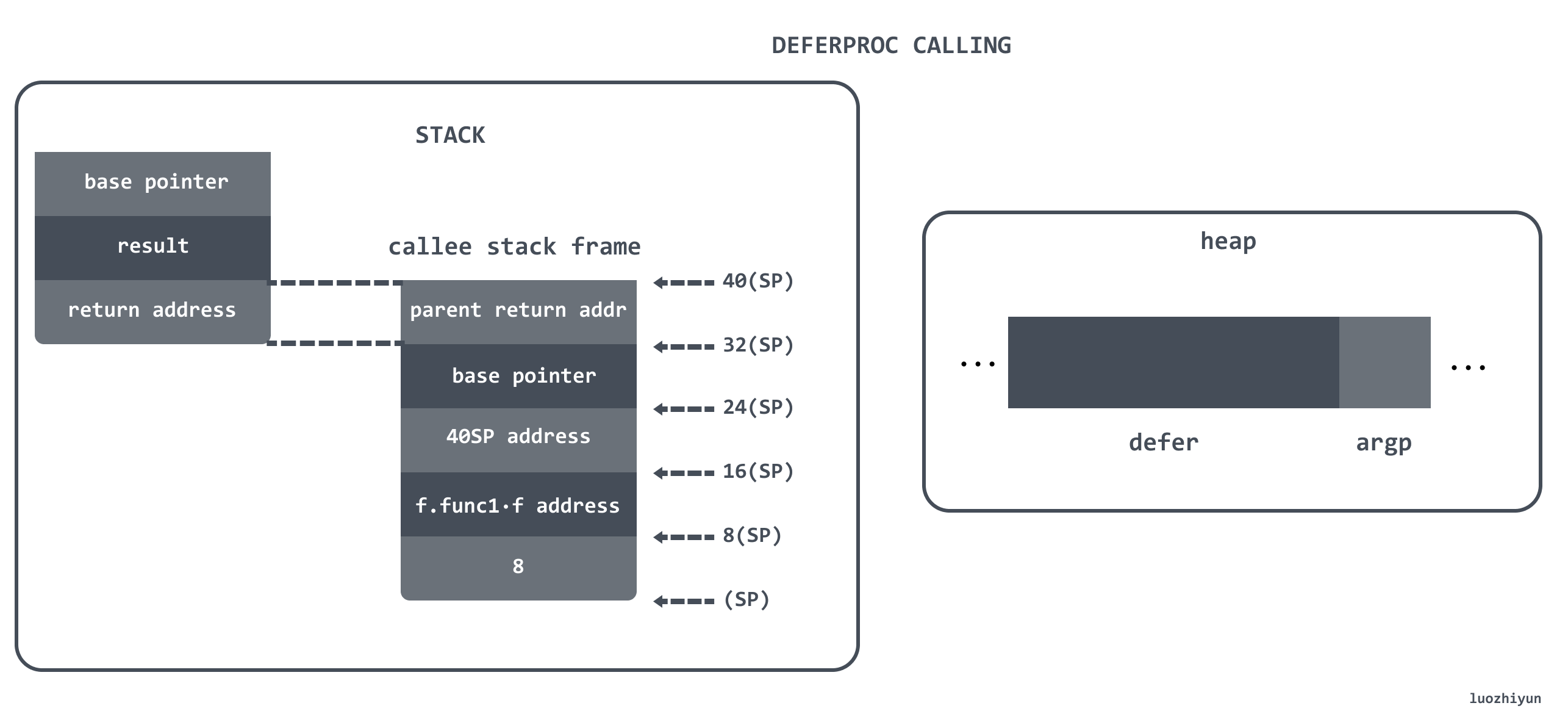
Note that here the argp value is copied by a copy operation, so the argument is already determined when defer is called, not when it is executed, but here the value of an address is copied.
And we know that when allocated on the heap, defer is stored in the current Goroutine as a chain, so if there are 3 defers called separately, the last one called will be at the top of the chain.

For the newdefer function, the general idea is to fetch from P’s local cache pool, and if not, fetch half of defer from sched’s global cache pool to fill P’s local resource pool, and if there is still no available cache, allocate new defer and args directly from the heap. The memory allocation here is roughly the same as the memory allocator allocation, so we won’t analyze it again, but you can see for yourself if you are interested.
Let’s go back to the assembly of the f function.
|
|
Here it is very simple, write constant 6 directly to 40(SP) as the return value and then call runtime.deferreturn to execute defer.
Let’s look at runtime.deferreturn :
File location: src/runtime/panic.go
|
|
First, note that the argument arg0 passed in here is actually the value at the top of the caller’s stack, so the following assignment actually copies the defer argument to the top of the caller’s stack.
|
|
*(*uintptr)(deferArgs(d)) What is stored here is actually the address value saved by the caller 16(SP). Then the caller’s stack frame is shown below.
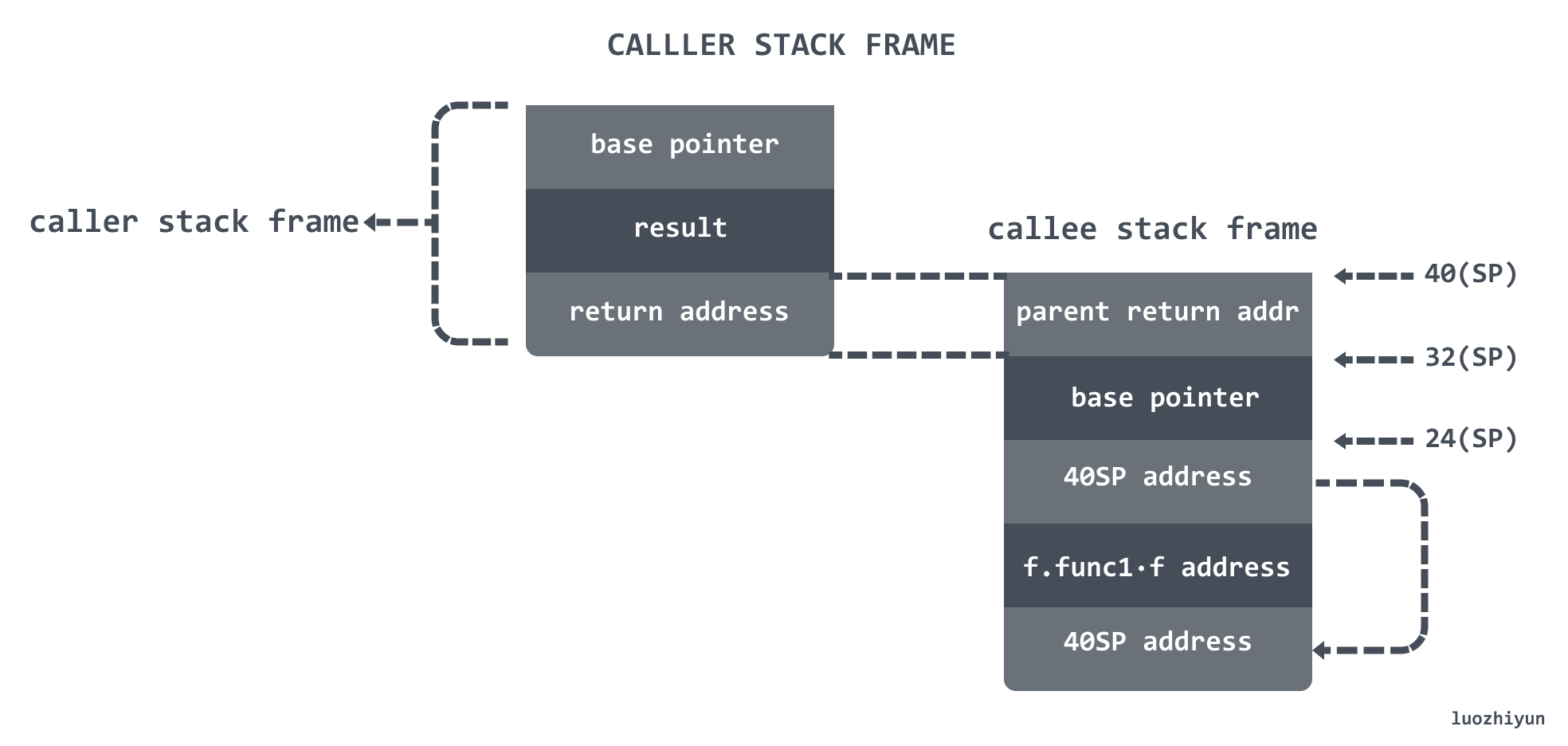
Go to runtime.jmpdefer to see how this is done.
Location: src/runtime/asm_amd64.s
This assembly is very interesting, the jmpdefer function, since it was called by runtime.deferreturn, now has the following call stack frame

The arguments passed to the jmpdefer function are 0(FP) for the fn function address, and 8(FP) for the SP of the call stack of the f function.
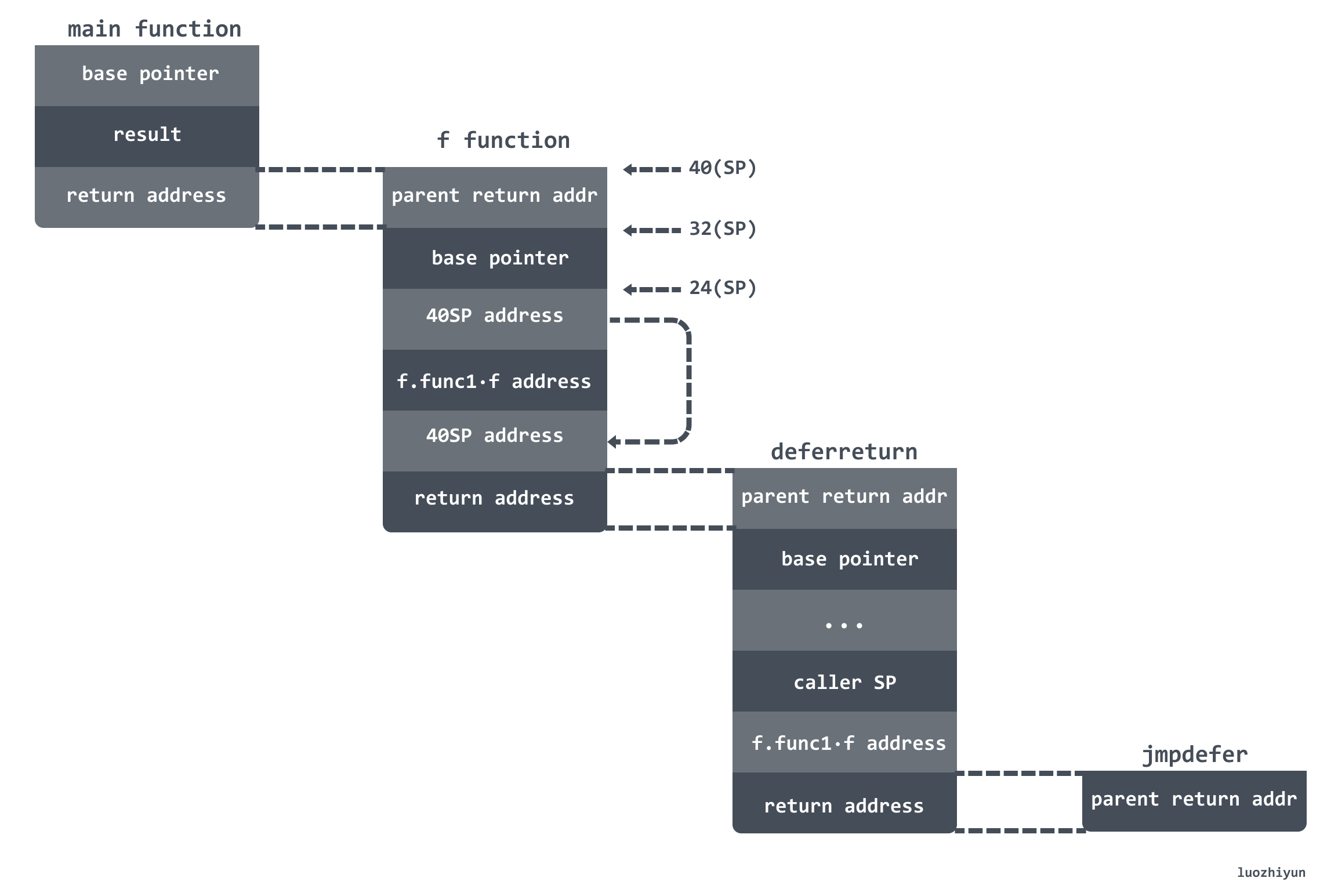
So the following sentence represents the return address of the runtime.deferreturn call stack written to SP.
|
|
Then -8(SP) represents the Base Pointer of the runtime.deferreturn call stack.
|
|
We will focus on explaining why the value of the SP pointer minus 5 is used to obtain the address value of runtime.deferreturn.
|
|
We return to the assembly of the f function call.
Since the runtime.deferreturn function needs to return to the 0x45defd address after the call, the return address in the stack frame corresponding to the runtime.deferreturn function is actually 0x45defd.
In the jmpdefer function, the value corresponding to (SP) is the return address of the runtime.deferreturn call stack, so subtracting 5 from 0x45defd will give you 0x45def8, which is the value of the runtime.deferreturn function. address.
Then when we finally jump to the f.func1 function, the call stack is as follows.
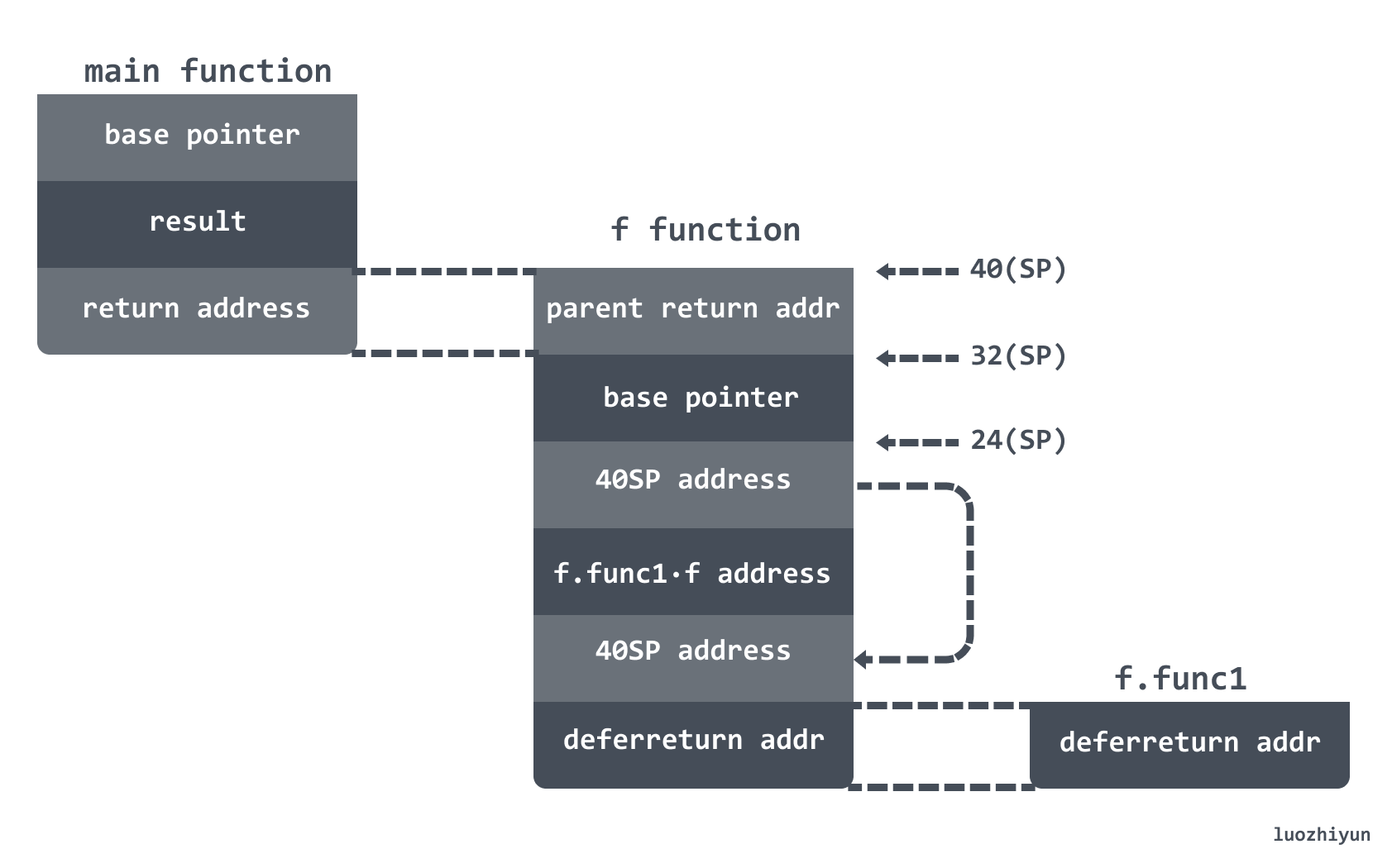
The location of the call stack (SP) actually holds a pointer to the deferreturn function, so after the f.func1 function is called, it returns to the deferreturn function until there is no data in the _defer chain.
Here’s another short look at the f.func1 function call.
|
|
The call here is very simple: get the data pointed to by the 8(SP) address value and do the arithmetic, then write the result to the stack and return.
Here we have basically shown you the whole process of calling defer functions through heap allocation. The answer is that the defer argument passed during the defer call is a pointer to the return value, so the return value is modified when defer is finally executed.
Anonymous function return value calls
So what if anonymous return value functions are passed? For example, something like the following.
Print the compilation below.
|
|
In the output above, we can see that the anonymous return value function call first writes the constant 100 to 24(SP), then writes the address value of 24(SP) to 16(SP), and then writes the return value to 48(SP) with the MOVQ instruction, which means that the value is copied, not the pointer, and so the return value is not modified.
Summary
Here is a diagram comparing the two after calling runtime.deferreturn stack frames.
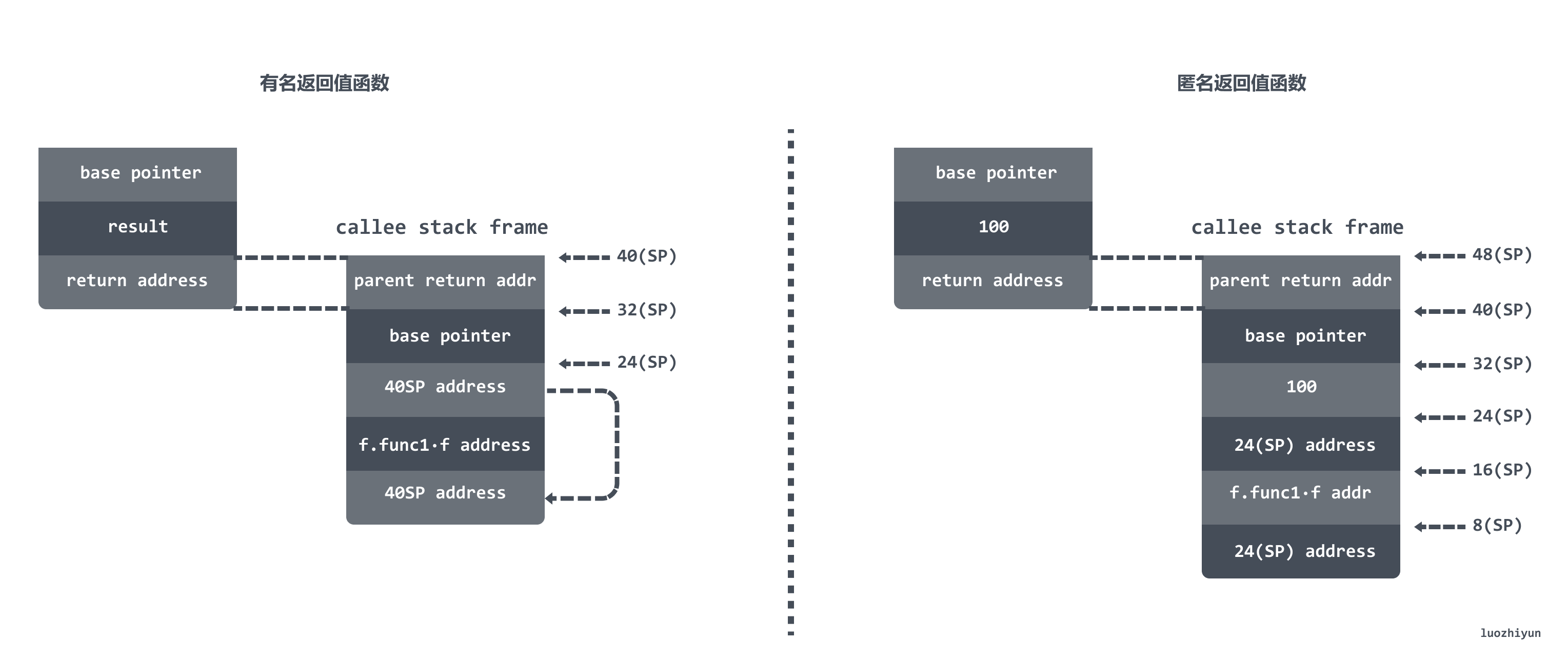
It is clear that the famous return value function stores the address of the return value at 16(SP), while the anonymous return value function stores the address of 24(SP) at 16(SP).
The above sequence of analysis also answers a few questions in passing.
-
how does defer pass arguments? We found in the above analysis that when executing the
deferprocfunction, the argument value is first copied to the location immediately adjacent to thedefermemory address value as the argument, if it is a pointer pass it will directly copy the pointer, and a value pass will directly copy the value to the location of thedeferargument.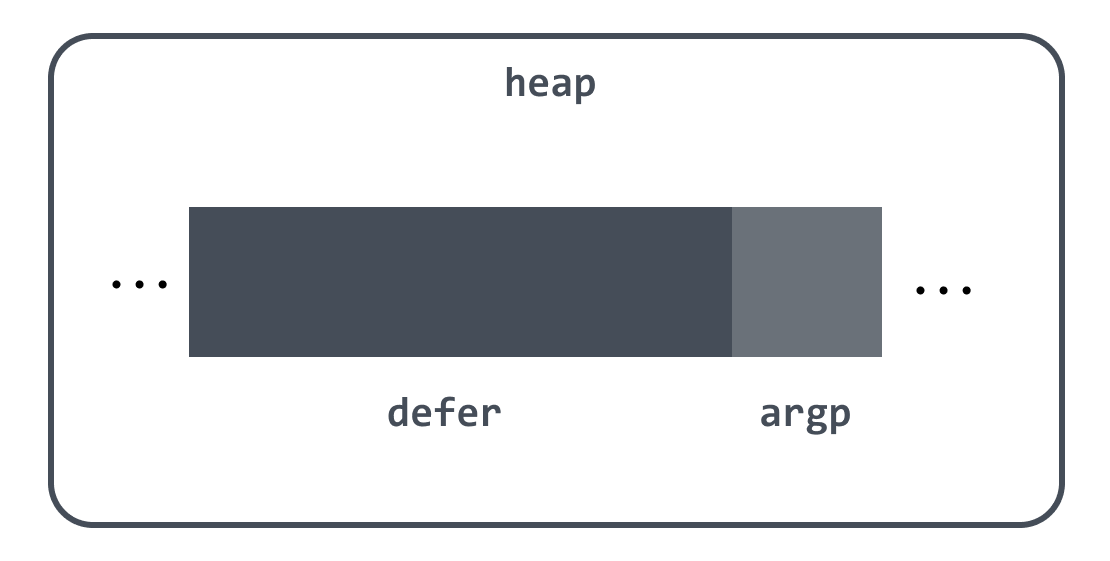
Then when the
deferreturnfunction is executed, it copies the parameter values to the stack and then callsjmpdeferfor execution.1 2 3 4 5 6 7 8 9 10 11 12 13 14 15func deferreturn(arg0 uintptr) { ... switch d.siz { case 0: // Do nothing. case sys.PtrSize: // 将 defer 保存的参数复制出来 // arg0 实际上是 caller SP 栈顶地址值,所以这里实际上是将参数复制到 caller SP 栈顶地址值 *(*uintptr)(unsafe.Pointer(&arg0)) = *(*uintptr)(deferArgs(d)) default: // 如果参数大小不是 sys.PtrSize,那么进行数据拷贝 memmove(unsafe.Pointer(&arg0), deferArgs(d), uintptr(d.siz)) } ... } -
How are multiple defer statements executed?
When the
deferprocfunction is called to register adefer, the new element is inserted at the head of the table, and execution is done by getting the head of the chain in order.
-
What is the order of execution of defer, return, and return value?
To answer this question, let’s take the assembly of the output in the above example and examine it.
1 2 3 4 5 6 7 8"".f STEXT size=126 args=0x8 locals=0x20 ... 0x004e 00078 (main.go:11) MOVQ $6, "".result+40(SP) ;; 将常量6写入40(SP),作为返回值 0x0057 00087 (main.go:11) XCHGL AX, AX 0x0058 00088 (main.go:11) CALL runtime.deferreturn(SB) ;; 调用 runtime.deferreturn 函数 0x005d 00093 (main.go:11) MOVQ 24(SP), BP 0x0062 00098 (main.go:11) ADDQ $32, SP 0x0066 00102 (main.go:11) RETFrom this assembly, we know that for
- it is the first to set the return value to the constant 6.
- then
runtime.deferreturnwill be called to execute thedeferchain. - executing the RET instruction to jump to the caller function.
Stack allocation
As mentioned at the beginning, defer on-stack allocation was added after Go version 1.13, so one difference from heap allocation is that defer is created on the stack via deferprocStack.
Go goes through the SSA stage at compile time, and if it’s a stack allocation, then it needs to use the compiler to initialize the _defer record directly on the function call frame and pass it as an argument to deferprocStack. The rest of the execution process is no different from heap allocation.
For the deferprocStack function let’s look briefly at.
File location: src/cmd/compile/internal/gc/ssa.go
|
|
The main function is to assign a value to the _defer structure and return it.
Open coding
The Go language was optimized in 1.14 by inlining code so that calls to the defer function are made directly at the end of the function, with little additional overhead. In the build phase of SSA buildssa will insert open coding based on a check to see if the condition is met. Since the code in the build phase of SSA is not well understood, only the basics are given below and no code analysis is involved.
We can compile a printout of the example for the allocation on the heap.
|
|
We can see in the assembly output above that the defer function is inserted directly into the end of the function to be called.
This example above is easy to optimize, but what if a defer is in a conditional statement that must not be determined until runtime?
The defer bit delay bit is also used in open coding to determine whether a conditional branch should be executed or not. This delay bit is an 8-bit binary code, so only a maximum of 8 defers can be used in this optimization, including the defer in the conditionals. Each bit is set to 1 to determine if the delay statement is set at runtime, and if so, the call occurs. Otherwise, it is not called.
For example, an example is explained in the following article.
https://go.googlesource.com/proposal/+/refs/heads/master/design/34481-opencoded-defers.md
At the stage of creating a deferred call, it is first recorded which defer with conditions are triggered by a specific location of the deferred bits.
Before the function returns and exits, the exit function creates a check code for the delayed bits in reverse order:
Before the function exits, it determines whether the position is 1 by taking the delayed bits with the corresponding position, and if it is 1, then the defer function can be executed.
Summary
This article explains the execution rules of defer and introduces the defer type. The main purpose of this article is to explain how defer function calls are made through heap allocation, such as: function calls to understand “defer argument passing”, “how multiple defer statements are executed”, “and what is the order of execution of defer, return, and return value”, and other issues. Through this analysis, we hope you can have a deeper understanding of defer.